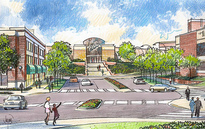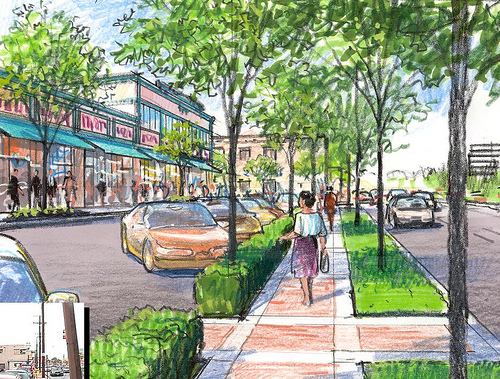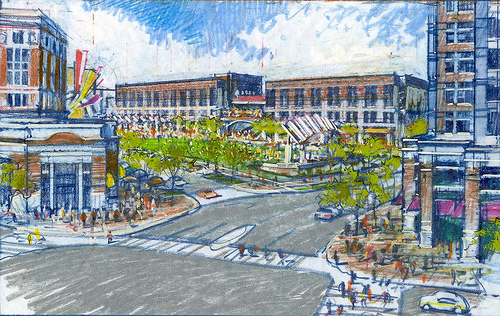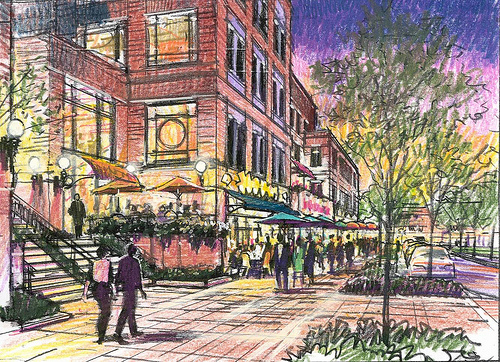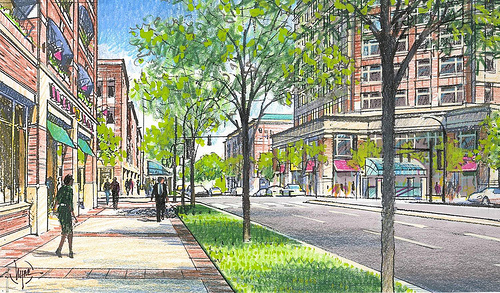Four visions of Wheaton, from new paint to tabula rasa
In 2004, Montgomery County followed up their 2001 Visual Preference Survey of Wheaton with a charrette, or design workshop, to turn residents’ suggestions into a vision for the community.
The county teamed up with the National Main Street Center, Baltimore-based architecture firm Allison Platt & Associates, and staff from the Planning Department to develop four concepts for how Wheaton’s downtown could be redeveloped.
Like last summer’s charrette in Burtonsville, the charrette resulted in four scenarios (outlined in this PowerPoint presentation) for Wheaton’s CBD.
The four, entitled “Fixer Uppper,” “Entertainment District,” “Residential Village,” and “Office Town Center,” ranged from making minor cosmetic changes to basically leveling the downtown core and starting over again. Nonetheless, all four proposals shared a few common elements, including:
- Turning all or part of Parking Lot 13, located at Grandview Avenue and Reedie Drive, into a public green.
- Streetscape improvements, especially along Georgia, Veirs Mill and University, including wider sidewalks, trees, and additional landscaping.
- Re-routing Ennalls Avenue between Grandview and Georgia to improve traffic circulation and create more regularly-shaped blocks for easier redevelopment.
- Visually and physically connecting “Wheaton Plaza” (the plan pre-dates the mall’s purchase and renaming by Westfield) to the rest of the CBD to encourage shoppers to circulate between downtown and the mall.
The “Fixer Upper” scenario sought to retain Wheaton’s “eclectic image,” focusing on existing businesses and making “small scale improvements.” Surface parking would be added throughout the downtown, though some vacant lots could be used for infill development. Lot 13 would still be used for parking, but a site plan suggests using special pavers that could allow it to double as a plaza on special occasions. The strip malls along Georgia Avenue, shown above, would receive new façades but little else.
The “Entertainment District” scenario recasts Wheaton as a “center for music entertainment, equipment and production,” building on the renown of Chuck Levin’s Washington Music Center on Veirs Mill Road. Space would be set aside for recording studios and artist housing. A cluster of night clubs would be created. Much of the downtown core would be leveled; Lot 13 would be completely closed to auto traffic and turned into an outdoor performance hall, shown above.
The “Residential Village” scenario seeks to form Wheaton as a neighborhood center, not a regional destination. Vacant properties would be developed as townhomes and mid-rise apartments or condominiums. Retail would be mainly local-serving, like supermarkets, though this scheme still proposes redeveloping the strip mall between Georgia and Triangle Lane, shown above. Lot 13 would become a leafy “village green” with a civic building and a playground.
The “Office Town Center” scenario focuses on bringing jobs to Wheaton, clustering office uses around the Metro station. High-rise buildings would be encouraged along Georgia Avenue at Reedie Drive, shown above, and a site plan proposes razing all of the Downtown core for parking garages and new buildings. Big-box stores would be built around Wheaton Plaza Westfield Wheaton mall. Of the four proposals, this seems to provide the least amount of open space, turning only part of Lot 13 into a plaza.
None of these four scenarios could really “fix” Wheaton by themselves, but each contains smaller ideas that can and will be combined to create a solid revitalization plan. While some proposals seem pretty outrageous — turning Downtown into a mini-Merriweather Post Pavilion, for instance — they’ll be a better gauge of public opinion while encouraging unorthodox solutions for improving the CBD.
Some of the things first outlined in the charrette, like the walkway connecting Georgia Avenue and Triangle Lane, have already been done. Others, like expanding Wheaton Plaza, happened in ways not anticipated by these plans. But they did represent yet another step in the decades-long push to revitalize Downtown Wheaton, one that would eventually culminate in the Wheaton CBD Sector Plan that we’ll see early next year.
Visit the Mid-County Regional Services Center‘s website (and scroll all the way down) to see this and other documents on the Wheaton revitalization.

